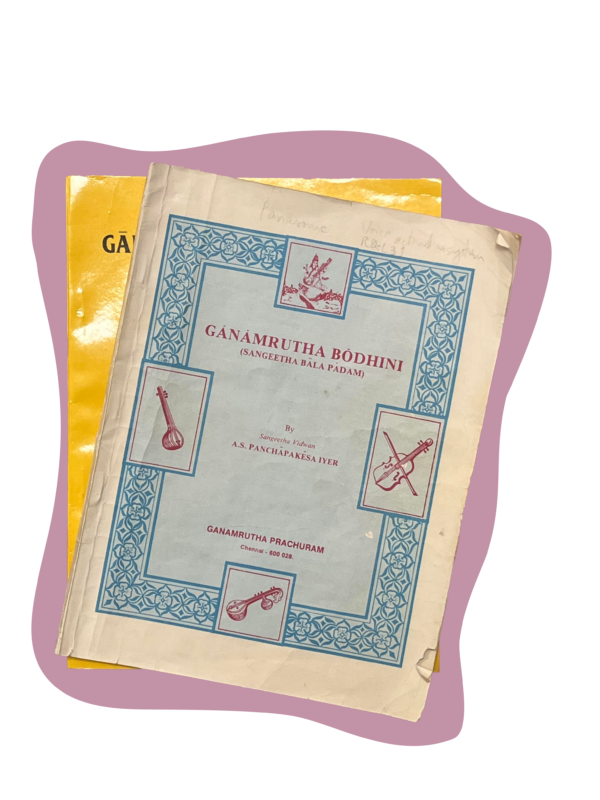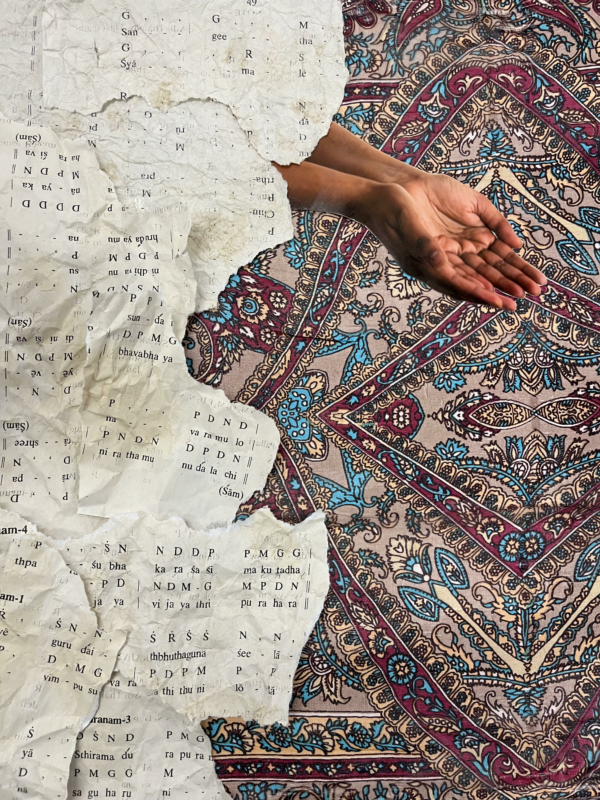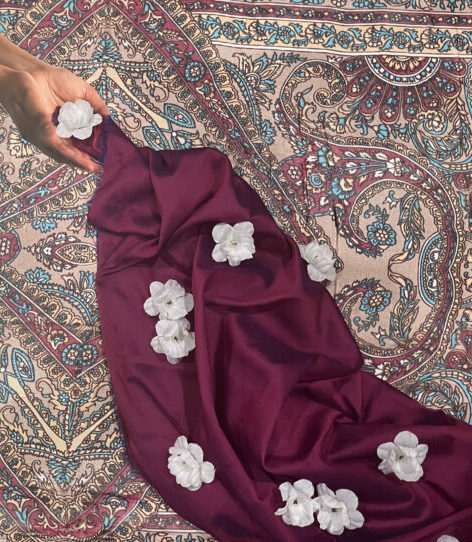Introduction

For the Explorations unit, we were given the opportunity to explore a new skill in depth and expand on our existing passions. For my project, I created a 3D mixed media collage by combining various elements that connect me to my family. I chose to create a mixed-media collage because I knew from the beginning that I wanted to explore physical design, as I lacked experience. Through 3D mixed media, I could utilize items in my home to make a piece that holds significance to me, my culture, and my family while creating something brand new.
Process


My first step was borrowing some Carnatic music books from my dad. Carnatic music is a style of traditional music in Karnataka, India. My family is from Karnataka, so I thought it would be fitting to incorporate some of the music sheets in my collage. I did this by scanning the pages I liked, printing them out, and then staining the papers with tea to make them beige and crumpling them to make them wrinkly for texture. I enjoyed this part of the process because I like the smell of tea, so it was very therapeutic!
My next step was taking a photo of my mom’s hand. I had her position her hands like she was pouring something out of them, and then I took a photo and printed it. I also used a shawl I purchased on a trip to Pondicherry, India for the background because I liked the symmetrical pattern it had when it was spread out. Pondicherry was once a French colonial-settlement so the town is filled with French architecture and an interesting blend of Indian and French elements. The shawl reminds me of the Summer I spent there with my family.

I then used Mod Podge to seal all the pieces together in an arrangement I liked!
I wanted to make it look like water was flowing out of my mom’s hands, so I decided to use some sari blouse fabric that she’d given me. I wanted the sari fabric to have a lot of folds to make it look fluid and show form, so I used super glue to glue each fold together until I was satisfied.

I then added artificial flowers to make it look like flowers were flowing through the “water.” I chose these white flowers specifically because they kind of reminded me of the jasmines that grow in my grandma’s front yard. I’ve liked the smell of jasmine since childhood and its fragrance reminds me of her and spending time in her home.
To finish off the piece, I added extra details like gold beads on my mom’s wrist to resemble bangles and a tiny trinket box my grandma bought me at a street shop.
Here is my final product!

From the explorations project, I learned a lot about composition and risk-taking. As a person who is better inclined to digital design, I am used to having an undo button and being able to try out different arrangements and styles in a piece before deciding on one. However, in this project, I had to take some risks and trust myself that the composition of my piece would look okay in the end. In the beginning, I spent a lot of time worrying if my ideas would look good, but closer to the end, I began going with the flow and I got a lot more done. Hopefully, the practice I gained in composing and risk-taking will help me work with improved speed and confidence in my digital designs.
Watch my explorations presentation here:
Music Recording

For the music recording project, I and Sylvia C. worked together to create a voice and viola cover of “Fly Me To the Moon” by Frank Sinatra. Neither of us had done a duet like this before, so we were excited to try it together! We got to record our parts in the recording studio and learn to use professional music recording equipment. I then used Pro Tools to put our parts together and make a proper cover. Through the music recording project, I learned a lot about how musicians record their music and I’m excited to create more projects there in the future! It was a super fun experience, and I’d definitely do it again.
Listen to our cover below!

Artist statement: I created a cover of “Fly Me To The Moon” by Frank Sinatra with Sylvia C. One of the main reasons we chose this song is because we thought it would sound interesting as a voice and viola duet, and we both liked the song. Sylvia sang the lovely vocals, and I played the viola part. Learning to use Freestyle Academy’s recording studio was a cool experience and I felt (almost) professional. I’d love to record more music in there for a future project. After completing this project, I’m most proud of our ability to make changes on the fly. Sylvia and I picked out the song just two days before recording and hadn’t practiced it together beforehand. In the recording studio, we had to make some changes to our parts, and Sylvia had to sing an octave lower than what she was used to. Overall, I’m happy with our result, and I’m sure Sylvia and I will make even cooler music next time we try recording together.
Lyrical Essay
A lyrical essay is an abstract form of writing that is often written stylistically with poetic devices and metaphors. There is no one way to write a lyrical essay, making it a unique style of creative writing. To develop a strong understanding of what makes a quality lyrical essay, we studied various authors in English class including Ryan Van Meter, Claudia Rankine, and Ross Gay. We also looked at “Consider the Lobster,” a creative nonfiction piece by David Foster Wallace. I found Wallace’s work very inspiring and it influenced me to write my own satirical piece for the unit. You can read my lyrical essay below!
Unity in Culture: How South Asian Gen Z Are Fighting Racism
How a South Asian-American woman is reclaiming her cultural practices and spearheading online movements against racism.
By Dhrithi Vishwa
Before Anjali Srinivasan would leave for school each morning, her mother would massage her head with coconut oil, combing through the hair with her fingers and then tying it into two tight braids with two red ribbons. According to Srinivasan, the Bangalore fragrance in her shiny black plaits, slick with thick coconut oil, made her stand out at school.
“One time, a white kid said my hair smelled funny,” says Srinivasan. “That’s when I first started feeling self-conscious about my oiled hair.”
With each experience, Srinivasan untied one of her ribbons until she began to leave her hair down and refuse hair oil entirely, much to her mother’s dismay.
“She was like, ‘It’s good for you,’ and I was like, ‘It’s embarrassing’,” Srinivasan says, laughing as she twirls her hair between her fingers.
Thankfully, Srinivasan’s disdain for hair oil didn’t last forever, and it wasn’t long before she put her ribbons back on. As she grew older, she began to find herself in growing South Asian communities on social media.1 These communities, filled with South Asian women, were reclaiming cultural practices that they were ridiculed for as children. The communities helped Srinivasan come to see the hair oil in a new light and influenced her to braid her hair once more.
Inspired by the work of her peers, Srinivasan started creating her own TikTok videos to discuss racism that affects the South Asian community. In her videos, she mentions how kids at school would call her Indian lunches gross and make fun of her oiled hair.2
“Sometimes, you think about all the extreme racism we experienced as kids, and you realize no one really talks about it,” says Srinivasan. “It’s a unique experience that unites all South Asians.”
Srinivasan’s TikTok videos went viral and garnered national attention, and she was invited to share her culture by performing Garba, a traditional dance from the Indian state of Gujarat, for PM Modi and President Biden at a White House dinner.3

The dance, typically performed in festivals, is meant to honor and worship divine forms of femininity and pays respect to many Hindu goddesses. It is also often performed to mark a girl’s first menstrual cycle.4
The Garba performance was heavily anticipated and watched by South Asians around the world, but it received some mixed reactions. Srinivasan received backlash from some South Asians for associating with PM Modi. However, she ultimately received overwhelming support from the Indian community.5
When other South Asians questioned her support for Modi after the revoke of Article 370 in India, Srinivasan shut them down quickly.6
“[Modi] is really doing great things for India. I know not everyone thinks so, I know that. But as a South Asian, as an Indian, I believe he has changed the country for the better,” says Srinivasan.

While Srinivasan enjoyed her experience performing for PM Modi and President Biden, she doesn’t wish to get involved in politics.7 Having built a haven for herself and other Indians on her TikTok page, she prefers to remain in the comfort of content creation to empower other Indians. However, she wouldn’t be opposed to giving another performance.
“I’m just glad Indians are finally being recognized for who we are and the beautiful culture we have,” she says. “I hope my videos can continue to help other Indian-Americans out there tackle racism and feel confident in their two red ribbons.”
1 I still remember the day I decided to attend a South Asian Student Union club meeting in 10th grade just to watch the club president stumble over Bengali customs before spending three minutes on how “cool” the Bollywood star Shah Rukh Khan is. I often wonder, are these communities truly for South Asians, or is the label “South Asian” mainly being used by Indians trying to appear as inclusive?2 It’s always the hair oil and the stinky lunches, the epitome of our experiences with racism. Grade school microaggressions often appear to be the most traumatizing experience of my community, and they must be consistently discussed in mainstream media.
2 It’s always the hair oil and the stinky lunches, the epitome of our experiences with racism. Grade school microaggressions often appear to be the most traumatizing experience of my community, and they must be consistently discussed in mainstream media.
3 DeshGujaratHD. 2023. “Garba in White House ; Modi, Biden, First Lady of America Watching It.” YouTube. June 22, 2023. https://www.youtube.com/watch?v=4dImHeB6wtk.
4 The Editors of Encyclopedia Britannica. 2019. “Garba | Dance.” In Encyclopedia Britannica. https://www.britannica.com/art/garba.
5 Center, Pew Research. 2023. “Indians’ Views of Modi and Other National Leaders.” Pew Research Center’s Global Attitudes Project. August 29, 2023. https://www.pewresearch.org/global/2023/08/29/indians-views-of-modi-and-other-national-leaders/.
6 Www.bbc.com. 2023. “Article 370: India Supreme Court Upholds Repeal of Kashmir’s Special Status,” December 11, 2023. https://www.bbc.com/news/world-asia-india-67634689.
7 The model minority myth and the desire to keep our status as the “tolerable” ethnicity has only let our community become willfully ignorant. Racism and oppression, especially in India, will always be connected to politics, but the diaspora turns the other way time and time again.
Bibliography
Center, Pew Research. 2023. “Indians’ Views of Modi and Other National Leaders.” Pew Research Center’s Global Attitudes Project. August 29, 2023.
https://www.pewresearch.org/global/2023/08/29/indians-views-of-modi-and-other-nation
al-leaders/. Accessed 5 June 2024.
This shows the approval statistics of Modi from Indians. The majority of Indians are in favor of Modi and his Hindu nationalist party, BJP. A large reason for why many Indians are in favor of him is because he fosters anti-Muslim sentiment through propaganda which leads to many Hindus in India feeling like Muslims are dangerous and Hinduism must be preserved, even though Hinduism is the main religion followed in the country and Muslims are a minority group. I used this source to show that, even though many Indians support his actions, many other South Asians are against him due to nationalism, and the disregard that Indians have of their voices while also overtaking the label of “South Asian” is harmful.
DeshGujaratHD. “Garba in White House ; Modi, Biden, First Lady of America Watching It.” YouTube, 22 June 2023, youtu.be/4dImHeB6wtk?si=C1WZFTIJteaKOA5i. Accessed
5 June 2024.
This is one of the few videos documenting the White House Garba performance in 2023. In the video, you can see numerous Garba dancers performing for President Joe Biden, First Lady Jill Biden, and PM Modi. The dancers were diaspora Indians, and one of them is the family friend of a close friend of mine, which is how I found out about this event. My friend’s family friend supposedly disregarded Modi’s problematic tendencies and praised him for the actions he’s taken for India. Diaspora being large supporters of Modi is not uncommon, and a large part of it is due to ignorance of his party’s Hindu nationalist politics. I used this source to emphasize the leverage PM Modi gains through diaspora and their ignorance. This gives him a lot of power internationally and he can utilize the support to push for more dangerous policies.
Sebastian, Meryl, and Sharanya Hrishikesh. “Article 370: India Supreme Court Upholds Repeal of Kashmir’s Special Status.” Www.bbc.com, 11 Dec. 2023,
www.bbc.com/news/world-asia-india-67634689. Accessed 5 June 2024.
This article describes the upholding of the removal of Kashmir’s “special status” which allowed it the autonomy to operate similarly to an independent state. PM Modi’s government removed the special status in 2019 with protests from many Kashmir citizens. I used this source to highlight one of the reasons why many South Asians are opposed to PM Modi and his government’s nationalist agendas. It should not be lost on Indians that citizens of Kashmir are South Asian and deserve autonomy and to be listened to. It is also worth noting that the majority of Kashmir’s population is Muslim, and the state’s right to autonomy being taken away does fit with the Hindu nationalist agendas of the openly Islamophobic BJP leaders.
The Editors of Encyclopedia Britannica. “Garba | Dance.” Encyclopedia Britannica,2019, www.britannica.com/art/garba. Accessed 5 June 2024.
This article defines “Garba” and explains the significance of the dance in honoring fertility, femininity, and divine Hindu goddesses. I used this source to highlight the irony in performing a dance rooted in purity and divinity for a manipulative leader who creates oppressive policies to remain in power.